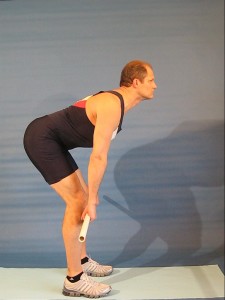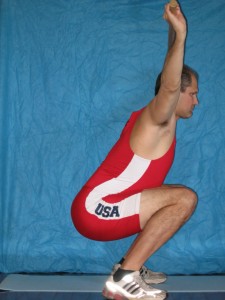Does Strength Training Help Improve Your Flexibility?
March 25, 2009
Recent research has look at this question with interesting results. Most often people use passive stretching as the main method to try and increase flexibility in particular muscle groups. Passive stretching has been shown to improve flexibility if consistently done over a long period of time. The question is can you combine your flexibility training into a strength program? And if so what movements improve flexibility?
An article posted in the Journal of Strength and Conditioning Research in May of 2008 titled “Influence of Strength Training on Adult Women’s Flexibility” (Monteiro, Simao, et.al) looked at how 10 weeks of strength training influenced flexibility in sedentary middle-aged women. The exercises used in the study included bench press(free-weight), Smith squat machine, anterior wide grip lat pull-down, 45-degree leg press, 30-degree inclined bench press, hack squat machine, and abdominal crunches. The average age of the women in the study was 37 years + 1.7 years. This particular study demonstrated that after training for 10 weeks and going through three (3) circuits of 8 to 12 repetitions of the seven (7) exercises listed above, that significant improvements in range of motion occurred with the following movements; hip flexion and extension, trunk flexion and extension and shoulder horizontal adduction. The areas that did not improve range of motion where elbow and knee flexion. While this study did show that strength training can improve flexibility in sedentary women, the next question is are there strength exercise movements that can improve flexibility in rowers? To my knowledge there are no studies that have looked at rowers and how strength training would influence flexibility. The above study did demonstrate increased hip flexion, which is critical in rowing, and so the use of the squat machines did increase hip flexion range of motion. What the above study did not look at is how hamstring mobility was affected by the above strength training program. This would have a lot of relevance to an effective rowing stroke.
From my own coaching experience I believe that there are several key lifting movements that will certainly increase flexibility in rowers in a positive way, if they are done properly. These strength movements include the “overhead squat” and “straight-leg dead lift”. Both of these lifts require a higher level of body control and awareness and people who attempt these positions should try and get a professional to look to make sure proper technique is being used. In general these open movements are better than strength training machines used in the above study. This is because the neural input needed from the athlete is greater with open movements, and the carry-over is probably better as well.

Straight Leg Dead Lift

Over Head Squat
“Other research on flexibility training has focused on developing effective strategies to increase the range of motion and identifying the factors that limit flexibility. There has been some disagreement over whether one’s limitation’s in flexibility is really from the inability to completely relax the involved muscles. Studies have shown that range of motion is much greater when a person is completely anesthetized, Walsh (1992) suggested that the inability to relax is a major limitation in the range of motion about a joint.” (Enoka, 2002).
Often we hear our coaches tell us how important it is to relax in the boat of no the erg which will help to produce a long and powerful stroke. Relaxation allows for a more complete range of motion through all the joint movement in the rowing stroke. Training movements repeatedly help to improve relaxation of a motion. There are few sports that require as much flexibility as rowing (Olympic lifting and Gymnastics), so flexibility is a critical component to effective and powerful stroke rowing strokes.
**When strength training it is advised that you are under the supervision of a trained professional to assist with proper technique to reduce injury risk.
Have a Great Training Day!
Coach Kaehler
References;
Enoka, Roger M. Neuromechanics of Human Movement. New York: Human Kinetics, 2001.
“Influence of Strength Training on Adult Womens flexibility.” Journal of Strength and Conditioning Research, 22 (3), 2008: 672-77.
May 8th and May 9th – Greenwich Water Club, CT
March 22, 2009
Structural Evaluation Time Slots
All Structural Evaluations will be done at the Greenwich Water Club.
Friday, May 8th:
1:30 – 3:00 pm – Booked
3:00 – 4:30 pm – Booked
4:30 – 6:00 pm – Booked
7:00 – 8:00 pm – Lecture
8:00 – 9:00 pm – Demonstration and Questions
Saturday, May 9th
6:00 – 7:30 am – Pending
7:30 – 9:00 am – Available
9:00 – 10:30 am – Booked
10:30am – 12:00pm – Booked
12:00 – 1:30 pm –Booked
1:30 – 3:00 pm – Available
** Additional times are possible, please contact Coach Kaehler.
Turkish Get-Ups: One arm
March 6, 2009
Lunges -Weighted: One and Two Arm
March 6, 2009
Medicine Ball Toss
March 4, 2009
Dumbbell Swings
March 4, 2009
Thrusters with Dumbbells
March 2, 2009
